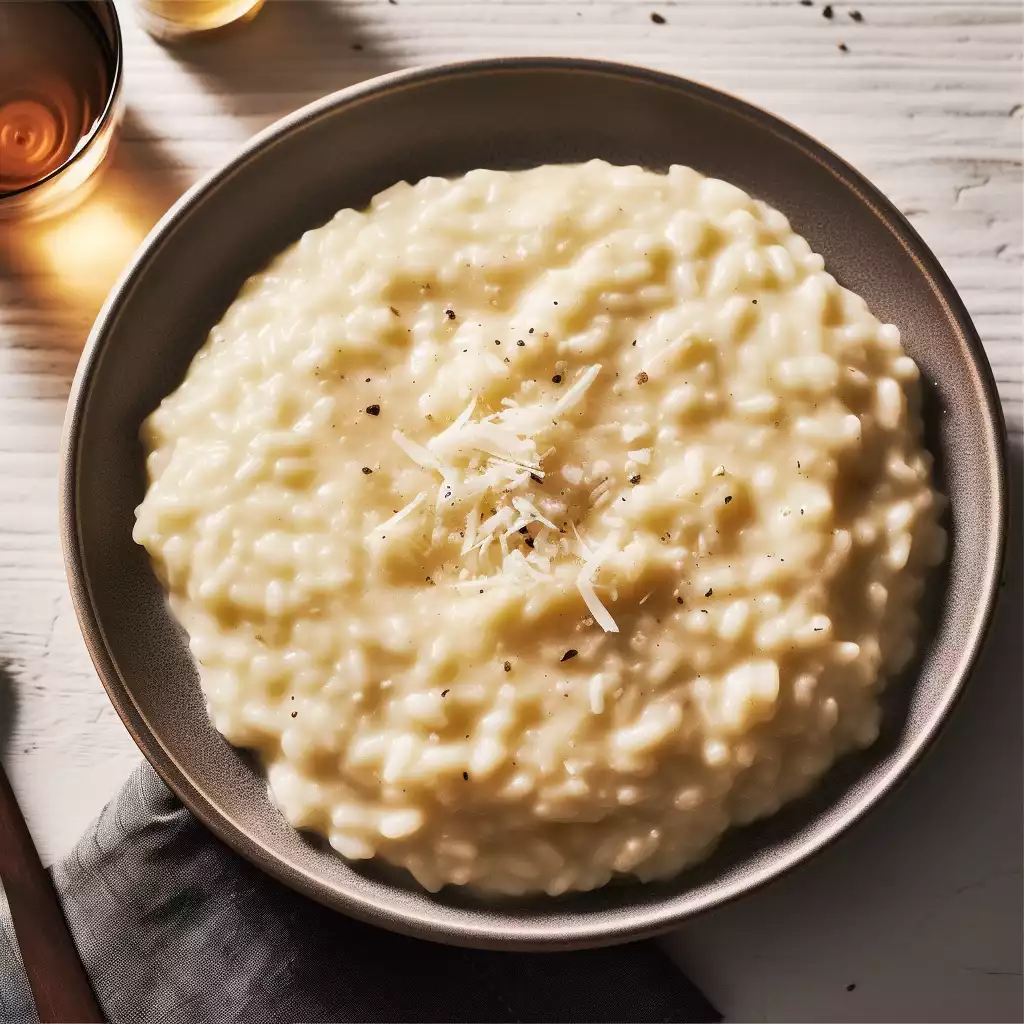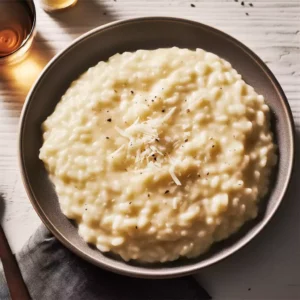
The Classic Risotto, a cornerstone of Italian cuisine, has long captivated food enthusiasts worldwide. Its roots trace back to Northern Italy, specifically to the Lombardy region, where rice paddies are abundant.
Historians suggest that the Arabs, who introduced rice to Italy during the Middle Ages, played a significant role in the development of this dish.
Over time, the simple combination of rice and broth evolved, incorporating local ingredients and cooking techniques, thus giving birth to the risotto we know and love today.
The classic risotto is revered for its creamy texture and rich flavour. This seemingly simple dish requires a certain finesse to achieve perfection. For beginners, it’s a fantastic way to hone your cooking skills, as it teaches patience and the art of balancing flavours.
The key lies in the constant stirring, allowing the Arborio rice to release its starch and create that signature creaminess.
One of the most wonderful things about risotto is its versatility. While this recipe focuses on a classic version, there are countless variations to explore. Each region in Italy boasts its own version, from Risotto alla Milanese, infused with saffron, to the seafood-rich Risotto alla Pescatora of the coastal areas.
You can tweak this basic recipe to include a variety of ingredients such as mushrooms, seafood, or seasonal vegetables. Each variation not only alters the taste but also the cultural story behind the dish.
The classic risotto, as presented here, uses Arborio rice, a staple in Italian cooking known for its ability to absorb liquids and flavours. This specific type of rice contributes significantly to the dish’s creamy consistency, while the grains remain firm to the bite.
The choice of Arborio over other rice varieties is crucial to achieve the desired texture.
The inclusion of onion and garlic lays a flavourful foundation for the dish. Their aromatic qualities when sautéed, elevate the overall taste, making them indispensable in the recipe.
The vegetable broth, another key component, is added gradually, allowing the rice to slowly absorb the liquid and flavours. This method is essential for achieving the creamy texture that risotto is famous for.
The final touch, a blend of Parmesan cheese and butter, is stirred in off the heat. This step, known as ‘mantecare’ in Italian, is crucial. It enriches the risotto, adding a luxurious, velvety finish. The dish is then seasoned with salt and black pepper, allowing you to adjust the flavours to your liking.
In addition to its delicious taste, risotto is celebrated for its comforting qualities. It’s a dish that warms the soul, perfect for cosy evenings or special occasions. It’s also a great way to impress guests with your culinary skills, as a well-made risotto is always a crowd-pleaser.
Overall, preparing a classic risotto is an enriching experience. It teaches patience, precision, and the joy of creating something truly special from simple ingredients.
Remember that the beauty of risotto lies in its simplicity and the love you put into it. Each stir, each ladle of broth, brings you closer to mastering a dish that has been cherished for centuries. So, grab your saucepan, and let’s start cooking this timeless Italian classic.
Expert Tip: To enhance the flavour of your risotto, toast the rice in olive oil until the edges become translucent before adding broth. This step releases the rice’s natural nuttiness, adding depth to the dish.
Cooking a classic risotto is like painting a picture. Each ingredient adds a unique stroke of flavour, creating a masterpiece of taste. Let’s explore why these specific ingredients are chosen and how they contribute to the final dish.
Arborio Rice: The hero of our risotto, Arborio rice, is preferred for its high starch content. This starch is key to the creamy texture of the risotto. When cooked slowly, it releases this starch, binding the dish together.
If you can’t find Arborio, Carnaroli or Vialone Nano are good substitutes, though they might slightly alter the texture.
Onion: Often underestimated, the onion is crucial for building the initial layers of flavour. It adds a subtle sweetness and depth, which balances the richness of the other ingredients. Shallots could be used as an alternative, offering a milder taste.
Garlic: This adds an aromatic quality, enhancing the overall flavour profile without overpowering the dish. If garlic isn’t your thing, you can reduce the amount or skip it, but you’ll miss out on that extra layer of flavour.
Vegetable Broth: The choice of broth greatly influences the risotto’s taste. Vegetable broth keeps it light and allows the rice’s flavour to shine through. Chicken or beef broth can be used for a richer taste, though this will change the dish’s character.
Parmesan Cheese: Parmesan cheese brings a nutty and salty dimension to the risotto. It also contributes to the creamy texture. If Parmesan isn’t available, Grana Padano or Pecorino Romano can serve as alternatives, offering different levels of saltiness and tang.
Olive Oil: It’s the starting point for cooking, providing a medium for sautéing the onions and garlic. Its subtle flavour is important in setting the stage for the other ingredients. A good quality butter or a mild vegetable oil can be used, but they will slightly change the flavour.
Salt and Black Pepper: These seasonings are simple but vital. They enhance and balance the flavours of the risotto. Their quantities can be adjusted according to personal preference.
Unsalted Butter: Added at the end, butter gives a luxurious, silky finish to the risotto. It rounds off the flavours and adds richness. If you prefer a lighter version, you can reduce the butter or substitute it with a light cream.
Fresh Parsley: This garnish isn’t just for looks. It adds a fresh, herbal note to the dish, contrasting the richness of the risotto. If parsley isn’t your favourite, try chives or basil for a different twist.
From the starchiness of the rice to the umami of the cheese, they all come together to create a dish that’s more than the sum of its parts. Remember, cooking is about making it your own, so feel free to experiment with these ingredients to suit your taste!
Expert Tip: Always warm your broth before adding it to the rice. Adding cold broth can shock the rice and affect its ability to absorb the liquid evenly, which is crucial for a creamy texture.
While Arborio is the traditional choice for risotto due to its high starch content and ability to maintain a firm texture, there are alternatives. Carnaroli and Vialone Nano are excellent substitutes, each bringing a slightly different texture to the dish.
Using regular long-grain rice isn’t recommended, as it lacks the necessary starch to achieve the classic creamy texture of risotto.
The key to perfect risotto is achieving ‘al dente’ texture, where the rice is cooked through but still has a slight bite to it. It typically takes about 18-20 minutes of cooking after the first ladle of broth is added. The risotto should be creamy and flow gently when served, not too thick or runny.
Risotto is best enjoyed fresh, as its creamy texture is due to the starch released during cooking. However, if you need to prepare it in advance, cook it until it’s slightly underdone, cool it quickly, and refrigerate. Reheat it gently, adding a little broth or water to loosen it up. Remember, the texture may not be as creamy as when freshly made.
Absolutely! For a dairy-free or vegan risotto, omit the Parmesan cheese and butter, or use vegan alternatives. There are many plant-based cheese and butter substitutes available that can mimic the richness and creaminess of their dairy counterparts.
To incorporate more protein, consider adding cooked chicken, shrimp, or even plant-based protein like tofu. Add these towards the end of the cooking process to ensure they’re heated through but not overcooked.
Leftover risotto can be transformed into delicious arancini – risotto balls stuffed with cheese, coated in breadcrumbs, and deep-fried. It’s a tasty and creative way to use up leftovers and enjoy a completely different dish.
Freezing risotto is possible, but it may affect the texture, making it less creamy. If you decide to freeze it, ensure it’s cooled quickly and stored in an airtight container. To reheat, thaw it in the refrigerator and then warm it up slowly, adding a bit of broth or water to adjust the consistency.
Expert Tip: Finish your risotto off the heat by adding butter and Parmesan. This final step, known as ‘mantecare’, is essential for achieving that luxurious, creamy consistency that risotto is famous for.
Here are some more recipes for you to enjoy! If you my recipes don’t forget to rate and leave a comment.
If you have any recipe suggestions, please do not hesitate to ask me. A great way to stay in contact with me is through Instagram, Facebook, Twitter and YouTube. Don’t forget to tag me @CookwithNabeela in your recipe photos!

Subscribe now to receive my latest recipes directly in your inbox. Stay up-to-date and never miss out!

I love to cook! I want to share with you my favourite, delicious family-friendly recipes. I want to inspire you to create fantastic food for your family every day.
Add your first comment to this post